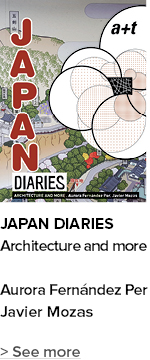Portraits
May 26, 2008

Article written by Xavier González
Savory and plump, and melting in the tea, la petite madeleine has become, even for those who have not read Proust, the object-symbol that summarizes remembrance, the survival of images and the sudden re-emergence of the past within the present. Spontaneously we recognize those things once familiar to us and which, from somewhere deeply buried in our recollection are suddenly revived through the madeleine’s mysterious savor.
In Matière et mémoire, Henri Bergson underlines this phenomenon of the simultaneity of the past and the present, for the Proustian child is, foremost, an adult who remembers having loved certain beings and certain places. Memory, however, overrides the emotional boundaries of recollection and of the simple recognition of things past.
Computer memory, ROM memory, RAM memory, genetic memory, collective memory, cultural memory, identification memory, proto-memory... memory. Memory has become a key word in our contemporary consciousness and the quest of memory-ness seems, at times, to offer a solution against the erasure of references as well as a safeguard against the loss of identity.
“Memory is an essential element of what is defined as either individual or collective identity, the quest of these later is one of the main activities of both contemporary individuals and societies in their fever and their anguish” (1) Memory and identity thus appear to be intrinsically linked. Identity being wrought of recollection and forming, with it, a mode of resistance against erasure and forgetting. “Identity: derived fiction originating in the powerful swells of memory” (2)
If, as Friedrich Nietzsche so deplored, the previous century was heavily based upon a historical culture, “a passion for History,” the invention of photography has facilitated the establishment and the continuity of a memory based upon events and upon the family. These traces, these grains of emulsion on paper, serve not only to fix a present forever in flight but also to enable the transmission of memory and thus its survival. Places once visited, moments of shared joy, historical events, this freezing of the camera frame, suspends time in order to return it to “those present”, in the form of individual or collective memory.
Photography has long been considered a minor art form, however it is actually one of the most widely used media in contemporary art. Perhaps because it responds best to the iconogorrhea that is so clearly characteristic of our epoch and so fully exposes its alarmingly ephemeral facet, the instant of the click, “the past that is no more, the future that is not yet, and the present that vanishes the very moment it emerges” (3)
Memory and indentity Seydou Keïta The art of portraiture expresses perhaps most clearly the search for identity and the cult of memory, “the portrait is designed to conserve the image in lieu of the person regardless whether their absence is caused by distance or by death” (4)
With the invention of photography, the portrait becomes its logical extension. It liberates the “subject” from the issues of subjectivity or painterly skill, in favor of an identicity. The issue of resemblance is definitively evacuated. The photographs become the subjects, their identity, their twin. Seydou Keïta and August Sander, each through their own approach, have investigated portraiture, and each with radically different angles, have been able to invent new measures of representation in the domain of collective memory and cultural identity. The Malian artist Seydou Keïta began his work in Bamako in 1949. Starting as a travelling photographer, he passed from fair to village festival to photograph families, friends, brides and bridegrooms, capturing and immortalizing these moments of shared joy. From this elementary approach, Seydou Keïta turns portraiture into an art form; through his vision and his choice of omposition, he participates in the establishment of a common “memory core” necessary for any fledgling nation.
Through the vision of his photographs, abstract time disappears, becomes a sum of faces, unravels itself, following the rhythm of markets, festivals and fairs, of Sunday walks, courtships, marriages, circumcisions, etc. The expressive power of his photos is direct and it touches us because the film captures and fixes the features of each face, the geometric designs of the clothes and holds each one of these particular moments that marks the continuum of our lives and structures our family and collective memories. These images make up a veritable archive : a composed memory of the Malian society. But even beyond their own cultural lineage, these unknown faces have an impact that by analogy sends us to our own recollections to the futility of forever trying to hold back time, “life/death: the paradigm is reduced to the mere click of a shutter, the one that separates the initial pose from its final printed form”(5)
In these photos, the earthen floor and a stretched cloth form the entire setting. The backdrops are often patterned fabric: their use becomes a significant element in the graphic composition and, as in certain paintings by Gustav Klimt or Henri Matisse, the subjects are “outlined” by interweaving organic and geometric lines, giving the image an “inner world without depth”
Memory and indentity - August Sander
The work of August Sander, 1876-1964, is most known for his important series Menschen des 20Jahrhunderts– an imposing document, the classification of which lies at the convergence of the fields of ethnology, historical documentation and sociology of the time. In his work, Sander observes his fellow citizens and the whole of German society as a ource from which to take his “working material”. In a mode similar to Carl von Linné, Sander will define a precise system of classification by social groups, thus generating an inventory and then sorting each of these according to type such as rural or urban, by class, by trades, by genders etc, arriving finally his own discover of the archetype. Sander begins his investigation in the milieu he knows best, that of the rural farmers, their life and their activities, then he will investigate the craftsmen and the workers, often representing them with the tools characteristic of their trade; next he will do portraits of women and a diverse range of social categories, including artists and big city dwellers. Sander completes this anthology with marginalized social groups, such as tramps, blind people, dwarfs, ect.
If the constitution of this veritable portrait gallery, Deutschenspiegel (mirror of the German people) represents the first corpus of work in what is about the creation of a memory, the second is defined by the process of classification itself. “Classification, including the irregular and the arbitrary, safeguards the wealth and the diversity of the inventory; by deciding that one must acknowledge everything, he facilitates the construction of a recollection” (6)
Remembering like forgetting, is a means of classifying, the organization in one’s memory based upon characteristics that are still to be determined; to unite what is similar, to separate what is different. It is from this ordering of the world that an individual may then construct and develop his or her own identity.
The work of August Sander will have a considerable influence on the evolution of photography in Germany and especially on the Düsseldorf School. His influence is clearly evident in the work of Bernd and Hilla Becher.
If the personal and human vision of Seydou Keïta disassociates itself strongly from the abstract and taxonomical vision of August Sander, the works of both artists, nevertheless, evoke an inner world, an intimacy of subject that becomes both support and substance; both subjectivity and sujectility; both twin and stranger within one single identity.
Memory and heritage - Bernd y Hilla Becher
The attitude revealed in the work of Bernd and Hilla Bechner is a clear extension of the documentary work undertaken by August Sander and is based on the process of identification, of inventory by type, and of classification. Sander “photographed people as we might photograph objects, Sander encouraged them to re-present themselves as though they were a character or role. Perhaps the objects and factories that we photograph can also re-present their own character” (7)
The comparison, however, ends here. If the works are through certain facets, comparable, the work of Bernd and Hilla Bechner attains a true conceptual dimension, inscribing it more clearly within a contemporary framework.
Their approach is based on a powerful analytical given: the progressive disappearance of an industrial landscape and heritage which is primarily composed of vernacular architectural objects. This given exposes the often ephemeral destiny of this functional architecture once praised and emulated by Le Corbusier and Gropius.
However, this architecture was never originally designed with the intention of transmitting ideas or values to posterity, its raison d’être consisted solely in the production, the manufacture, the transformation or storage of specific products. Beyond this functionality, these seemingly timeless buildings, that can at times reach sizes equal to those of cathedrals, reveal themselves to be fragile giants. The development of technology, the rise in operating costs, the fall in prices, and the subsequent decrease in profits have caused their sudden obsolescence and the gradual desertion of their locations.
The photos present a series or architectural objects treated as autonomous and almost completely disconnected from their context. The portraits are taken from a directly frontal view, like an architectural elevation, almost devoid of a vanishing point. The late morning light erases any shadows and any sense of depth, dissolving any possible subjectivity. The choice of framing in these shots are like “anthropometrical” index cards, veritable portraits, the portraits of prisoners condemned to death. These inexpressive figures, pale in tone, and displayed without nostalgia are then classified and exhibited in an extension of this same attitude, by families of functionality: water tanks, blast furnaces, gasometers, mine heads, etc.
These installations, ordered according to type, take on a playfulness which arising from the simple pleasure of the game of discovery and comparison. But almost as soon, this first impression dissipates, leaving a feeling of uneasiness. Indeed, each portrait contains a hidden reading that is more human, more emotional, evoking the ghostly presence of the economic crisis, the tragedy of unemployment and the efforts to restructure a large number of devastated regions.
The work of Bernd and Hilla Becher, whose investigations begin in the early sixties, has a dual influence in Germany as much at the political level as at the cultural level (8)
At the time when post war Germany was completing its reconstruction, the issue of a built heritage did not kindle any real interest; the country had, in a sense, lost its memory, had become amnesiac, and as after any traumatic experience, any interest towards the past was completely buried. If at first their work of cataloguing did not provoke any concrete changes of attitude on the part of political and cultural authorities, it did play an important role in increasing the awareness and educating their contemporaries in the manner in which they viewed the world. The question of industrial heritage and its adaptive conversion has become, today, a topic of public interest and the Ruhr basin is a clear example of this evolution.
The memory duty - Christian Boltanski
Christian Boltanski, born in Paris in 1944, is a conceptual artist. His work is emblematic of the experimental art of recent decades. Although he has experimented with different media such as “mail-art”, glass boxes, “seynettes comiques” from the theatre of the absurd, and in situ installations, the core of his work consistently centres upon the subject of memory at its most emotional level.
This direction, sometimes carried to the point of morbidity, most often takes the form of installations in which the development of each topic is always preceded by a search for identity.
This relationship with identity and memory takes on a diversity of forms:
Glass cases containing a selection of photographs of people and of personal objects such as a lock of hair, a school notebook, etc. Installations which catalogue and display all of the furniture belonging to one person, for example a deceased woman from Baden-Baden. Shadow theatres, that, using the same means as magic lanterns, project into darkened spaces the animated spectres that haunted the nightmares of our childhood.
But the great originality of Boltanski’s work is his ambiguous use of photography. “The photograph is felt to be a proof that the story being related is real, it gives the illusion of reality” (9) Starting with ordinary class photographs as his source material, Boltanski will transform these documents into “ready mades” of our collective memory. He will first re-photograph each face individually in order to reinstate the autonomy of each child. These faces, thus isolated, enlarged and framed, suddenly take on a tragic dimension. These black and white portraits of children are then positioned on walls or on the cover of metal biscuit boxes recalling the form of an alter. The tin frames are then outlined by electric bulbs. These compositions, evocative of funerary and commemorative monuments are displayed in semi-darkness. Boltanski reconstructs an atmosphere conducive to meditation such as may be found in certain chapels or surrounding Byzantine icons, but here, electric lighting has taken the place of the candles. Boltanski has done numerous variations on this form of installation, but it is perhaps, his re-presentation of the photograph of the Fête du Pourim that achieves the most intensity. This class portrait shows children dressed in costumes in a Yiddish school in Paris in 1939. If in this example the process of intervention upon an original photo is similar to previous works, its form will embody a particular investigation. The portraits are no longer outlined by light bulbs but are lit by directional lamps mounted on clamps evocative of those found in interrogation rooms, and the photos are displayed along with a wall of hung clothing. “The clothes and the photographs are simultaneously both a presence and an absence. They are both object and memory at the same time; in the same way that a dead body becomes both object and a memory of its subject” (10)
This association between the faces of the children and the clothing creates a sharp emotional tension, it gathers in a distilled form the tragedy of the holocaust and the concentration camps. Despite his own origins, Boltanski has always avoided using original historical documents and has abstained from citing the holocaust directly in his work. It is however present within the faces of these anonymous children, be they Jewish or not. It is perhaps that the annihilation of the memory and the identity of the deported proceeded their physical elimination and began originally in the replacing of names with registration numbers. Through this anonymity Boltanski’s photographs strike us all the more forcefully and remind us that the power of memory lies foremost in the reinstatement of names, in the naming itself, for to re-discover the name of a victim is to begin to rescue him or her from oblivion.
Memory and icons Yasumasa Morimura
In the work of Yasumasa Morimura, the link with memory is perhaps less clear and may seem more futile than in the works of the artists previously cited. Morimura’s work, focusing more particularly on the archetypes of Memory and icons Yasumasa Morimura
a universal cultural heritage, is more critical in scope and is inscribed within a vision and investigative mode linked to the Japanese culture. “In many senses, Morimura’s work depends on photography and thus traces back history and slips into the past” (11)
Morimura, who is based in Osaka, began to be known at the end of the eighties. His first pieces are presented as personal “dialogues” with the masterpieces from the history of art. His purpose is not to study their techniques, nor their compositions, nor even to re-interpret the subject, but rather to insert himself, according to the computer terminology, into each painting and to become the model. Morimura transforms his face at will and through the requirements of each painting, he becomes the man of a thousand faces: Mona Lisa of
Leonardo da Vinci, the “infante” of Las Meninas by Velázquez, the “olympia” of Manet and of Rembrandt and of Van Gogh, etc. He names his works “self-reflections”, an especially appropriate term since it contains both the concept of mirror and self-portrait. The issue raised, in fact, is one of self-portraiture, for in taking the role of universal and timeless models from the entire history of art, he transforms this entire body of work. His transformation-appropriations (détournement-appropiations) permit truth to coexist with fiction, reality with simulation. After his series based on the history of art, Morimura begins a second series entitled “Actresses”.
In this new investigation the faces are no longer simply incrusted in a pre-existing background or scene, but rather, his entire body appears, transformed, frozen, reconstructing a pose that in and of itself is symbolically representative of a given cult movie. He appears as Brigitte Bardot, as Lisa Minelli in Cabaret, as Vivian Leigh in Gone with the wind, as Marilyn Monroe in The seven year itch, replying the famous scene over the subway air vent.
If a first reading leaves room for confusion due to the over perfection of the poses and the expressions, or to the clothing which is often identical to the original models, a second reading leaves little room for doubt for the camera angles and settings become more autonomous. “I have so far performed some three hundred faces. It is an act of suspending the self of individuality, of diffusing one’s identity. This differs from the vision of Rembrandt and others that ultimately converges on the self. To me, making a self portrait is exploring the various possibilities I have” (12)
The choice of paintings and actresses is not, however, random. Focusing on the “golden standards”, Morimura explores the canons of art and of beauty according to western standards which have become the new universal archetypes. But these works are, foremost, clichés, symbols as evocative as Hollywood, Madonna, Mac Donald or Coca Cola... the signs of a dominant western culture that imposes its aesthetic criteria on the entire world.
Through the multiplicity of his faces, Morimura’s process is most representative of Japanese culture and perhaps hidden behind this game of role-playing lies a quest for identity –not only his own, but also that of his country. The empire of signs is, indeed torn between the attraction and the fullness of its acceptance of this global culture and between the meticulous conservation of its own cultural memory, a split which only too clearly illustrates the maxim in fashion: “Think global, act local”.
Article published in a+t 16. Memory I
Notes
(1) Le Goff. Histoire et mémoire. Paris Gallimard. 1988, p. 174
(2) José Jiménez. Memoria. Editorial Tecnos. Madrid. 1996, p. 34
(3) Joël Candau. Mémoire et identité. Sociologie d’aujourd’hui. Éditorial PUF, p. 57
(4) Jean Luc Nancy. Le regard du portrait. Éditorial Galilée 2000, p. 53
(5) Roland Barthes. La chambre claire: note sur la photographie. Paris. Cahiers du Cinéma. Gallimard/Seuil, pp. 144-145
(6) Claude Lévi-Strauss. La pensée sauvage. Paris. Éditorial Plon, 1962, p. 25
(7) Art Press, nº 209, p. 28
(8) Their cultural influence is also important. Bernd and Hilla Becher have taught in the Düsseldorf Art School for many years and have trained, directly or indirectly, an entire new generation of German photographers. This contribution is particularly evident in the work of Thomas Ruff and Thomas Struth, who were their students. It can also be seen in the work of Andreas Gursky and Gabriele Basilico. Like their teachers, they have focused upon ordinary architecture, in banality and in the representation of what is real. Memory is also knowing how to convey knowledge.
(9) Lynn Gumpert, Christian Boltanski
(10) Quotation of Georgia Marsh. The White and Black: an interview with C. Boltanski. Lynn Gumpert, Christian Boltanski, p. 118
(11) Quotation of the philosopher Motoaki Shinohara, in the article by Taro Amano. “Can Yasumasa save Humanity?” Exhibition catalogue of the Yokohama Museum of Art. 1996
(12) Intabyu Morimura Yasumasa: Owari naki saisei no shisutemu. Interview with Yasumasa Morimura: “A system of endless rebirth”. Hanga geijutsu 81, pp. 134-135






















 I've read and agree to
I've read and agree to 


